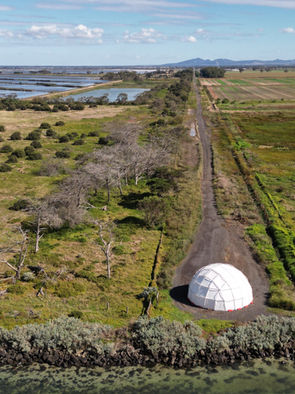
Reverberating Futures 2021
360-degree sound and film work
The southern hemisphere is currently experiencing unprecedented occurrences of algal drift, appearing as red tides during the day, noctiluca scintillans glow blue in the evenings crashing waves. Noctiluca Scintillans live in the ocean; they are nomadic and non-motile; they rely on the wind and the tide to move. Their glow works on a circadian rhythm, a 24-hour internal clock. They have a flagellum that extends from their cell, scooping phytoplankton, nutrients and other algae from the water as food. They use carbon and emit oxygen and are often useful as a bioassay tool to detect pollutants in water. Algae contribute 70% of the world's oxygen – it gives us life.
I am interested in the abstraction of ordinary experiences that allow audiences to encounter the possibility of recuperation in the age of the Anthropocene (Haraway 2016). Learning to culture and live with bioluminescent dinoflagellates in the laboratory and the field allows me to consider them as companion species. My research approach involves documenting Noctiluca Scintillans and other dinoflagellates with image, sound and film – creating digital representations of the research process. I am interested in the affect of their bloom and what the blooms actually mean. Awe and wonder create an affective impact in the same way a siren lures a sailor to their demise. The shimmer of the bioluminescent glow lures us into the reality of the impact of climate change.
Thinking with the ‘shimmer of the biosphere’(Bird Rose 2017), this work offers a reading of and for our times. This practice-led project is a creative enquiry for the future from a site on the western fringes of Naam, the Woiwurrung word for Melbourne, Australia – the Western Treatment Plant and what remains of a decommissioned township that once was the Treatment Farm in the parish of Cocoroc.







